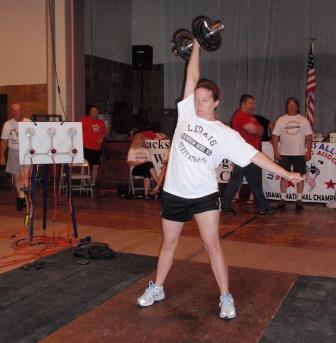by Larry Traub

2011 USAWA Women's National Champion Amber Glasgow in action with the Dumbbell Snatch at the 2011 USAWA National Championships. The Ledaig Club won all the major awards at the 2011 Championship - Best Female Lifter, Best Male Lifter, and Best Team. (photo and caption courtesy of the webmaster).
I was competing in the USAWA National Championship last June, and I had just completed my second cheat curl attempt. I was competing for the newly formed national champion team, Ledaig. After I completed the attempt I was approached by the founder and fearless leader of the Ledaig club, Dave Glasgow, who proceeded to ask me, “What were you smiling about before you went out to lift?”
There was a not too subtle implication in his question that I looked like an idiot. First, the attempt was successful, so the humiliation of looking foolish is superseded by attaining a successful lift. Second, maybe the foolish smile on my face facilitated the successful lift. Let me explain. As the bar was being loaded I was visualizing the performance of that particular lift, and of course, the successful completion of that lift. If completing a big lift on the platform brings a smile to your face then the visualization of that lift should do the same. I guess I was doing the thing that we’ve all been told not to do, and that’s, ‘counting my chickens before they hatch.’ I think that in this case the old adage fails us. Celebrating the success of the lift before the actual performance of the lift helps create the confidence and the desire to complete the lift.
Some studies have shown that in an activity that is primarily a skill movement, like shooting free throws, that mentally practicing may be just as effective as actually going to the gym and shooting. I don’t think that’s going to quite cut it in the lifting world, but I’m pretty sure that mentally doing a set of heavy squats, followed by the actual performance of that set might increase your chances of success.
We’ve probably all heard Yogi Berra’s quote, “90% of the game is half mental.” His game was, of course, baseball and according to my math (and I’m a math teacher) baseball would be 45% mental. In our game it might even be more than that, but who can put a number on it? A recent study shows that 67.3% of all statistics are made up on the spot anyway. The important thing would be recognizing how important it is to believe that you can perform a certain lift, and visualizing yourself doing it is a way of convincing your subconscious that it can be done.
Several years ago I was coaching a high school lifter at teenage nationals and he came up to me before his third attempt deadlift and said, “Coach, I don’t think I can pull this.” I just shrugged and told him that he might as well go to the scoring table and pass his third attempt. My coaching strategy at this point was to piss him off a little so he would get fired up and go pull the lift. I would like to tell you it was a brilliant piece of coaching that resulted in a big deadlift, but to tell you the truth, I don’t remember what happened. I do believe, however, that I had to make some effort to change his mindset. Telling him to go out there and give it his best shot would just reinforce his lack of confidence and would give him no opportunity for success.
Recognizing the mental aspect of our sport is one thing. Learning how to utilize this mental aspect may require some effort, but you may be drawing on a previously untapped resource, and tapping that resource just might take you to a new level of performance.




